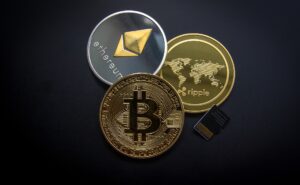Nikkei 225 is flat with February, when the BoJ started unloading government securities.
By Wolf Richter for WOLF STREET.
The Bank of Japan’s monstrous QE that had become part of the national economic religion of Abenomics under Prime Minister Shinzo Abe in early 2013 ended without fanfare. Following Abe’s announcement of his retirement in August 2020, Abenomics went out the door, and the BoJ began tapering its massive asset purchases in the fall of 2020.
And on its balance sheet as of October 31, released today, total assets, at ¥725 trillion ($6.36 trillion) were down a smidgen from the level at the end of August (¥727 trillion) and have essentially been flat since May except for minor fluctuations:

The BoJ has been shedding its holdings of Japanese government securities, starting in February 2021. Since then, its holdings fell by 2.2%, or by ¥11.9 trillion ($104 billion), to ¥528 trillion.
This was initially hard to see due to the fluctuations of these holdings as large long-term bond issues matured in one month and were redeemed by the government, and then in one of the following months were replaced by new securities.
These government securities amount to about 73% of the BoJ’s total assets. At the end of October, they consisted of ¥509 trillion of Japanese Government Bonds (JGBs) and ¥18.7 trillion of short-term Japan Treasury bills. The decline in the BoJ’s securities holdings since February was concentrated on these Treasury bills.

Stock ETFs, Japanese REITs, corporate paper, and corporate bonds were the most drooled-over part of the BoJ’s QE activities. The idea back in 2013 was that a central bank with unlimited buying power would buy lots of equities and drive up the beaten-down stock prices in Japan.
But the BoJ never bought much, and the total of all these categories combined, after all these years, amounts to ¥48.8 trillion, or only 6.7% of total assets. Of this, ¥36 trillion are stock ETFs, amounting to less than 5% of the BoJ’s total assets.
The BoJ stopped adding to them in February 2021, and the combined group has been roughly flat since then (red line in the chart below). The BoJ carries equities at market value, and the Nikkei 225 Index at 29,520 currently, is essentially flat with mid-February.
Loans (green line below), the second largest line item on the BoJ’s balance sheet after government securities (purple line), include the pandemic-era-stimulus “Special Funds-Supplying Operations” and the “Bank’s Loan Support Program” designed to stimulate economic growth via bank lending.
I also included the BoJ’s holdings of Government securities (purple line) for a sense of how small these purchases of equities and corporate credits have been, despite all the hype about them:

The long-term chart shows just monstrous the money-printing was under Abenomics:

In terms of the total amount of assets it purchased, in dollar terms, the Bank of Japan is in third place among the top three QE monsters, behind the ECB and the Fed. But the BoJ started 21 years ago, while the Fed and the ECB started 13 years ago. Now, combined, the three QE monsters hold nearly $25 trillion in assets:
- ECB: $9.69 trillion
- Fed: $8.56 trillion
- BoJ: $6.36 trillion.
For years, central banks got away with this monstrous money printing. It fired up asset price inflation, but it didn’t fire up consumer price inflation. Japan was held up as example. And then the Fed and the ECB jumped into it in 2008, and it didn’t fire up consumer price inflation either. And each step along the way, central banks thought, “so far, so good.”
But $25 trillion of money-printing by three central banks was bound to eventually trigger something, and possibly something Big, just when everyone had fallen asleep about the risks of money printing.
And we might be looking at that event now, on a global scale, with inflation raging in the US and Europe, and, mirabile dictu, even starting to take off in Japan, from -1.1% in April on a near-straight trend up to +0.2% in September.
Even as radical and monstrous stimulus continues globally with repressed interest rates and enormous balance sheets at central banks, there are now a lot of concerns that the inflation dynamics have woken up and will be tough and painful to tame if allowed to run.
Enjoy reading WOLF STREET and want to support it? Using ad blockers – I totally get why – but want to support the site? You can donate. I appreciate it immensely. Click on the beer and iced-tea mug to find out how:
Would you like to be notified via email when WOLF STREET publishes a new article? Sign up here.
![]()
Classic Metal Roofing Systems, our sponsor, manufactures beautiful metal shingles:
- A variety of resin-based finishes
- Deep grooves for a high-end natural look
- Maintenance free – will not rust, crack, or rot
- Resists streaking and staining
Click here or call 1-800-543-8938 for details from the Classic Metal Roofing folks.
- 100
- 2020
- 2021
- 7
- 9
- activities
- Ad
- All
- among
- Announcement
- April
- article
- asset
- Assets
- AUGUST
- Bank
- Banks
- beer
- Billion
- Bills
- Bonds
- buy
- Buying
- call
- Central Bank
- Central Banks
- consumer
- continues
- Credits
- Dollar
- Early
- ECB
- Economic
- Economic growth
- ETFs
- Europe
- Event
- Fed
- Fire
- Free
- Global
- good
- Government
- Green
- Group
- Growth
- hold
- How
- HTTPS
- idea
- index
- inflation
- interest
- Interest Rates
- issues
- IT
- Japan
- large
- lending
- Level
- Line
- loan
- Market
- metal
- money
- months
- Paper
- power
- price
- purchases
- Rates
- Reading
- religion
- retirement
- Run
- Rust
- Scale
- Securities
- sense
- small
- So
- sponsor
- started
- stimulus
- stock
- street
- support
- Systems
- top
- treasury
- us
- value
- years






